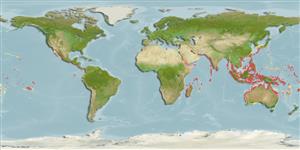Common names from other countries
Classification / Names / Names
Nomi Comuni | Sinonimi | Catalog of Fishes (gen., sp.) | ITIS | CoL | WoRMS
Environment: milieu / climate zone / depth range / distribution range
Ecologia
; distribuzione batimetrica 0 - 7 m (Ref. 102126). Tropical
Indian Ocean: from Iran to Madagascar, including the Persian Gulf, Aldabra, Seychelles, Mauritius and Réunion, east to India and south to Indonesia including Laccadive and Andaman Islands; Pacific Ocean: from China to the South China Sea south to Queensland, Australia including Federated States of Micronesia, Solomon Islands and Fiji, east to the Samoan Archipelago.
Length at first maturity / Size / Peso / Age
Maturity: Lm ? range ? - ? cm
Thalli erect, yellowish brown to dark brown in colour, attached by coarse branched holdfasts to rocky substrate, forming thick, huge colonies. Axes terete, muricate at the basal portion. Leaves are 6 to 12 mm long, consisting of a stalk, small vesicles and an expanded distal marginal blade outlined by coarse teeth; leaves triangular in outline or irregularly rounded in surface view; 3.5 to 9.0 mm across, sometimes deeply cut on one side, the cut often reaching the vesicle. Receptacular clusters 3 to 10 mm long, generally shorter and attached to the stalk of the leaves at 1/4 the distance from the main axis. This species is easily distinguished by its lax branched thalli, numerous branches, and small turbinate leaves with a length of about 1 cm or less. Thalli up to 1.5 m in height (Ref. 80758).
Used for human consumption, as fertilizer and insect repellant; contains minerals (Ca, K, Mg, Na, Cu, Fe, Zn); source of algin, tannins and phenols (Ref. 80758). Thrives mostly on sandy coralline bottoms on reef portions which are not exposed to excessive water turbulence; usually in shallow lagoons or tidepools in subtidal habitats protected from strong wave action (Ref. 80758).
Guiry, M.D. and G.M. Guiry. 2009. (Ref. 80701)
IUCN Red List Status (Ref. 130435)
CITES status (Ref. 108899)
Not Evaluated
Not Evaluated
Threat to humans
Human uses
Pesca: commerciale
| FishSource |
Strumenti
Informazioni ulteriori
Age/SizeAccrescimentoLength-weightLength-lengthMorfologiaLarveAbbondanza
Fonti Internet
Estimates based on models
Preferred temperature
(Ref.
115969): 24.6 - 29.3, mean 28.4 (based on 3837 cells).
